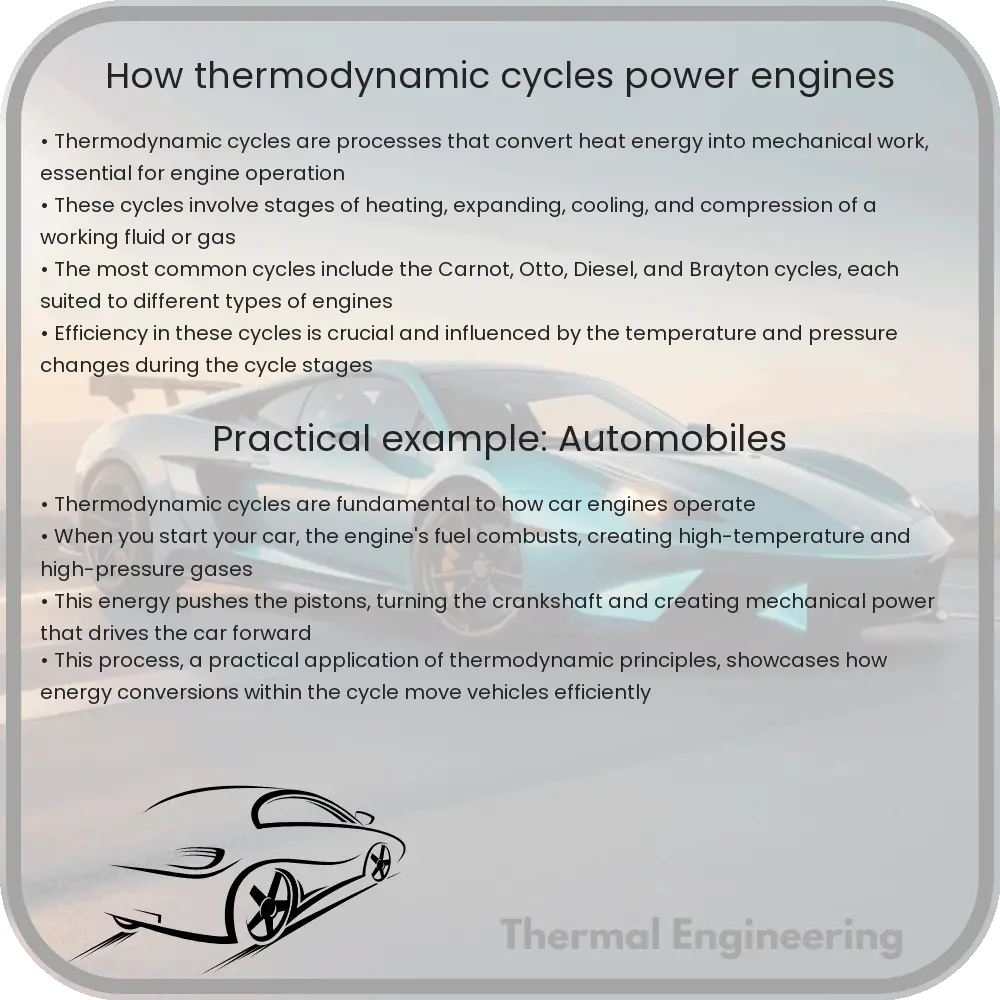Learn about thermodynamic cycles and their role in powering engines, from basic principles to efficiency limits governed by the second law of thermodynamics.

Understanding How Thermodynamic Cycles Power Engines
Thermodynamic cycles are the backbone of modern engine technology, converting the energy stored in fuel into usable mechanical work. This article explains the basic principles of thermodynamic cycles and how they power engines in a way that is easy to understand.
What is a Thermodynamic Cycle?
A thermodynamic cycle consists of a series of processes that involve the transfer and transformation of energy. In the context of engines, these cycles involve the compression, combustion, expansion, and exhaust of a working fluid—typically air mixed with fuel. The goal of these cycles is to convert the chemical energy in the fuel into mechanical energy that can move a vehicle, generate electricity, or power industrial machinery.
Key Processes in Thermodynamic Cycles
- Compression: The working fluid is compressed, increasing its pressure and temperature, and making it more reactive to ignition.
- Combustion: Fuel is injected into the compressed air, igniting it. The combustion process releases a large amount of heat, which raises the temperature and pressure of the gas substantially.
- Expansion: This high-pressure, high-temperature gas then expands within the engine. As it expands, it pushes against mechanical components of the engine (like pistons or turbine blades), converting the energy from the pressure and temperature into mechanical work.
- Exhaust: After the energy has been extracted from the gas, the exhaust process expels the spent gases out of the engine, making room for fresh air to start a new cycle.
Common Thermodynamic Cycles in Engines
There are several common thermodynamic cycles used in different types of engines:
- Otto Cycle: Used in most gasoline engines, involves a spark ignition.
- Diesel Cycle: Used in diesel engines, where ignition occurs due to high temperature from compression alone.
- Brayton Cycle: Utilized in jet engines and gas turbines, characterized by continuous intake and exhaust of air.
- Rankine Cycle: Often used in power plants and ships, involving a liquid-to-vapor phase change, generally using water.
- Stirling Cycle: Found in some external combustion engines and coolers, known for its high efficiency in some applications.
The Second Law of Thermodynamics and Engine Efficiency
The second law of thermodynamics states that the total entropy of an isolated system can never decrease over time. This law is particularly important in understanding engine efficiency, which is governed by the Carnot efficiency limit. The Carnot efficiency is given by:
ηCarnot = 1 – (Tc / Th)
where Tc is the temperature of the cold reservoir and Th is the temperature of the hot reservoir. In practical terms, this equation tells us that no engine can convert all of its heat energy into mechanical energy—there will always be some loss in the form of waste heat.
Conclusion
Thermodynamic cycles provide the fundamental framework for understanding how engines convert fuel into mechanical energy. By understanding these cycles, engineers can design more efficient engines that are capable of doing more work with less fuel and producing fewer emissions. Whether in cars, power plants, or aircraft, the principles of thermodynamics play a crucial role in powering the machines that make modern life possible.
With ongoing research and development in materials and technology, the future of engine design promises even greater efficiency and reduced environmental impact, all thanks to the application of thermodynamic principles.